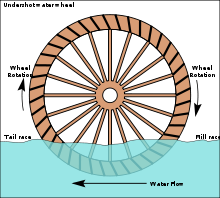An Introduction to Tidal Power
“The use of the energy generated by tides is an integral part of the history of the sea” (Roger H. Charlier and Loïc Menanteau).
Explaining the Tide:
Tides happen because of the pull of the sun and the moon on the earth. Each day there are two high tides, roughly 12 hours apart resulting from the moons position relative to the Earth. The water on the side facing the moon is pulled toward it, away from the sides, while the water on the opposite side also rises because the earth is being pulled toward the moon, but the water is lagging behind this pull.
Another cycle to take into account is the neap and spring tides cycle, which follows the placement of the moon in relation to the sun. Near New Moon and Full moon, Spring tides, or higher tides, occur, because the Sun and moon are both pulling the water, however neap tide, or lower tides, happen at the first and third quarter when the pull of the moon is somewhat cancelled out by the sun.
Tidal Energy:
The energy of the tide can either be harnessed through the kinetic energy as the tide flows, and/or through the potential energy of the water as it is kept in a basin as it comes in, and when the tide goes out, the water is then released through sluices, which as it passes through turns water-wheels. A mill only functions from three hours before to three hours after low tide, and depending on tidal range, was inefficient or unable to be used at neap tides.
Harnessing this power:
Until the second century BCE the tides and the sea had not been harnessed for use as power. At the beginning of the first century BCE the concept of harnessing water power using vertical water-wheels was suggested, however, and from here river mills, tide mills and mixed mills became ubiquitous. Most mills at this time were placed along rivers, however, not all settlements were located along rivers. Tide mills, or sea mills, came to be important for those lying on the coasts who did not have access to rivers. There were “mixed mills,” on some rivers that used the tides as well as the usual flow of the rivers for power.
Types of Water-Wheels Used:
The horizontal waterwheel, seems to have been in use in a tidal mill in Ireland as early as the 7th century C.E.. The first horizontal water-wheels were “undershot,” which meant that they were powered by the water as it flowed under the wheel. This new type of wheel was much more efficient than the vertical water-wheel, and spread quickly: seen in the Islamic empire by the 9th century C.E..
Another type of water-wheel was the “overshot” water-wheel which used both the kinetic and the potential energy of the water, as the water would fall onto the wheel, and the fall of the water, as well as it’s directionality were used to power the wheel. The “overshot” water-wheel was in use in Europe by 1338, but while this wheel was much more powerful, it was slow to gain popularity.
Format:
There are many different set ups for tidal mills, which are usually determined by geography, use, or tidal range. Not all coastlines will work for tidal mills, as many are too rocky or straight, inlets and indented coasts were necessary for tidal mills to operate. Tide mills appear to have been almost exclusively a European technology, outside of the a few examples of Muslim use of mixed mills. This was only until these countries expanded into the New World and other areas of the world, where they brought tidal technology with them.
The typical mill had a retaining pond where the water was stored at high tide, and released as the water level outside of the basin lowered. These ponds were filled via sluice gates in a dyke, which allowed water in, but not out. Once the tide has abated, the water in the pond is then let out through narrow gates which as it goes through, pushes the wheel. As mentioned before, there was much variation that occurred within this framework. The dykes varied in dimensions, as well as material, and the retaining pond varied greatly in size. The number of sluice gates, and also the number of water-wheels varied as well, as in Northern Europe few gates were used in comparison to the many used by the Spanish and Portuguese.
In the 12th and 13th centuries mill use expanded greatly due to the commitment to labour saving technology.
References:
Charlier, R. 2003. “A “sleeper” awakes: tidal current power”. Renewable and Sustainable Energy Reviews. 7 (6): 515-529.
Charlier, Roger H, and Loïc Menanteau. 1997. “The saga of tide mills”. Renewable and Sustainable Energy Reviews. 1 (3): 171-207.
Charlier, Roger H., Lo’ic Menanteau and Marie-Claire P. Chaineu. “The Rise and Fall of the Tide Mill.” In Ocean Sciences Bridging the Millennia: A Spectrum of Historical Accounts. Ed Selim Morcos, and Gary Wright, 315-338. Beijing: China Ocean Press, 2004.
Cotterell, Brian, and Johan Kamminga. 1992. Mechanics of Pre-industrial Technology: Introduction to the Mechanics of Ancient and Traditional Material Culture. Camb.U.P.
Hammons, T.J. 1993. “Tidal power”. Proceedings of the IEEE (Institute of Electrical and Electronics Engineers). 81:3: 419-433.
Smith, Norman Alfred Fisher. 1975. Man and water: a history of hydro-technology. [New York]: Scribner




Leave a comment
Comments 0